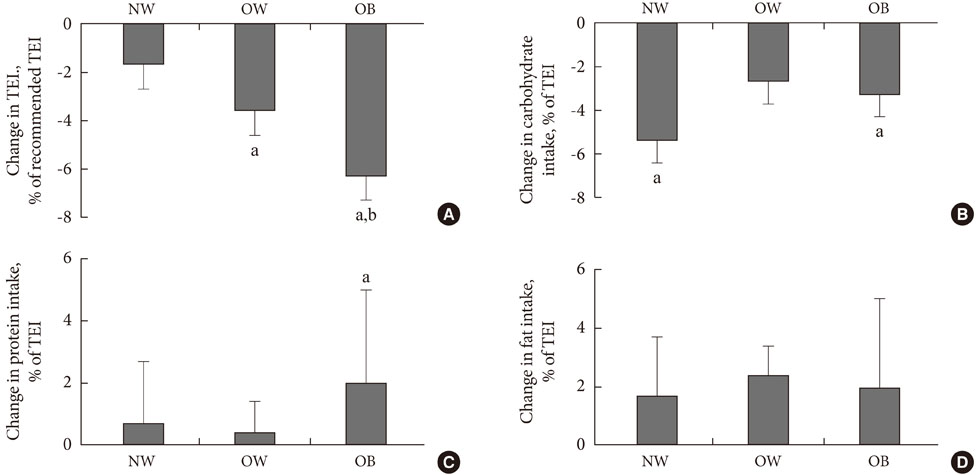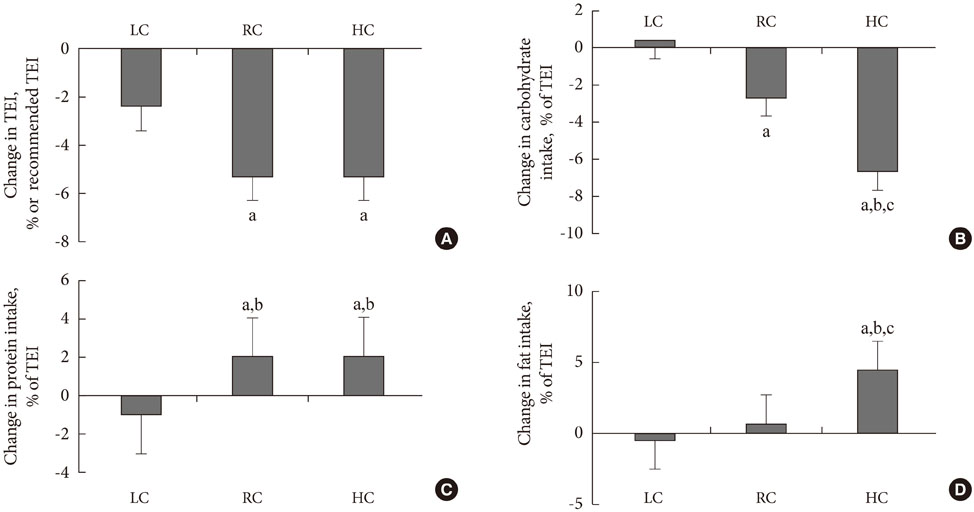Diabetes Metab J.
2011 Jun;35(3):273-281. 10.4093/dmj.2011.35.3.273.
Small Rice Bowl-Based Meal Plan for Energy and Marcronutrient Intake in Korean Men with Type 2 Diabetes: A Pilot Study
- Affiliations
-
- 1Diabetes Center, Eulji Hospital, Eulji University School of Medicine, Seoul, Korea.
- 2Department of Internal Medicine, Eulji University School of Medicine, Daejeon, Korea. minyungwa@gmail.com
- KMID: 2175435
- DOI: http://doi.org/10.4093/dmj.2011.35.3.273
Abstract
- BACKGROUND
Koreans eat rice, which is usually served in a rice bowl. We investigated the effect of a meal plan using small rice bowls on the total energy intake (TEI) and the marcronutrient intake in Korean men with type 2 diabetes.
METHODS
A total of 62 men with type 2 diabetes were divided by body mass index (BMI) (normal weight [NW], BMI<23 kg/m2; overweight [OW], 23< or =BMI<25 kg/m2; obese [OB], BMI> or =25 kg/m2) and proportions of carbohydrate intake to TEI (PCI) (low carbohydrate intake [LC], <55%; recommended carbohydrate intake [RC], > or =55% and < or =60%; high carbohydrate intake [HC], >60%). The 3-day dietary records were analyzed for TEI and proportions of macronutrients, before and 2 weeks after a small-sized (300 mL) rice bowl based education was given.
RESULTS
There were no significant differences in the age and BMI within the sub-groups by BMI and PCI groups. In baseline, the ratio of TEI to recommended total energy intake (RTR) of OW and OB were higher than that of NW. The PCI of HC was higher than that of LC and alcohol intake of HC was lower than that of LC. After education, the reduction of RTREI in OB was higher than that in OW and NW. The reduction of PCI in HC was higher than that of LC.
CONCLUSION
A small rice bowl based meal plan was effective for the reduction of energy intake and control of marcronutrient intake in Korean obese men with type 2 diabetes consuming a high carbohydrate diet.
MeSH Terms
Figure
Cited by 2 articles
-
The association between measurement sites of visceral adipose tissue and cardiovascular risk factors after caloric restriction in obese Korean women
Hye-Ok Lee, Jung-Eun Yim, Jeong-Sook Lee, Young-Seol Kim, Ryowon Choue
Nutr Res Pract. 2013;7(1):43-48. doi: 10.4162/nrp.2013.7.1.43.Comprehensive Understanding for Application in Korean Patients with Type 2 Diabetes Mellitus of the Consensus Statement on Carbohydrate-Restricted Diets by Korean Diabetes Association, Korean Society for the Study of Obesity, and Korean Society of Hypertension
Jong Han Choi, Jee-Hyun Kang, Suk Chon
Diabetes Metab J. 2022;46(3):377-390. doi: 10.4093/dmj.2022.0051.
Reference
-
1. Raidl M, Spain K, Lanting R, Lockard M, Johnson S, Spencer M, Sant L, Welch J, Liddil A, Hartman-Cunningham M. The healthy diabetes plate. Prev Chronic Dis. 2007. 4:A12.2. Nanri A, Mizoue T, Yoshida D, Takahashi R, Takayanagi R. Dietary patterns and A1C in Japanese men and women. Diabetes Care. 2008. 31:1568–1573.3. 2008 National Health Statistics. Ministry of Health, Welfare and Family Affairs, Korea Centers for Disease Control and Prevention. Available from: http://knhanes.cdc.go.kr (updated 2010 Jul 13).4. The Korean National Health Nutrition Examination Survey (KNHANES III). Korea Centers for Disease Control and Prevention. Available from: http://knhanes.cdc.go.kr (updated 2009 Mar 19).5. Korean Diabetes Association. A guideline for diabetes education. 2006. 2th ed. Seoul: Gold Agency;167.6. Ahn HJ, Koo BK, Jung JY, Kwon HR, Chung MY, Ku YH, Kim JT, Han KA, Min KW. Association between volume of bowls and the dietary intakes in subjects with type 2 diabetes. Korean Diabetes J. 2009. 33:335–343.7. Korean Diabetes Association, Health Insurance Review and Assessment Service. Report of task force team for basic statistical study of Korean diabetes mellitus: diabetes in Korea 2007. 2008. Seoul: Goldfishery.8. Wheeler ML, Franz M, Barrier P, Holler H, Cronmiller N, Delahanty LM. Macronutrient and energy database for the 1995 exchange lists for meal planning: a rationale for clinical practice decisions. J Am Diet Assoc. 1996. 96:1167–1171.9. Kitamura S. Diet therapy and food exchange lists for diabetic patients. Diabetes Res Clin Pract. 1994. 24:Suppl. S233–S240.10. Cho JW. The present status of diabetes education and opinion research of food exchange list. Korean Diabetes J. 2008. 32:S109–S114.11. Pedersen SD, Kang J, Kline GA. Portion control plate for weight loss in obese patients with type 2 diabetes mellitus: a controlled clinical trial. Arch Intern Med. 2007. 167:1277–1283.12. Camelon KM, Hadell K, Jamsen PT, Ketonen KJ, Kohtamaki HM, Makimatilla S, Tormala ML, Vale RH. DAIS Project Group. Diabetes Atherosclerosis Intervention Study. The Plate Model: a visual method of teaching meal planning. J Am Diet Assoc. 1998. 98:1155–1158.13. Sohn TS, Lee JM, Chang SA, Han KA, Son HS, Kim HJ, Ahn CW, Sung YA, Min KW, Baik SH, Yu JM, Park SW. The appropriate distance and duration of walking for exercise in patients with type 2 diabetes mellitus. J Korean Diabetes Assoc. 2007. 31:157–162.14. Korean Nutrition Society. Computer aided nutritional analysis program for professionals [CD-ROM]. 1998. Version 2.0. Seoul: Korean Nutrition Society.15. Franz MJ, Bantle JP, Beebe CA, Brunzell JD, Chiasson JL, Garg A, Holzmeister LA, Hoogwerf B, Mayer-Davis E, Mooradian AD, Purnell JQ, Wheeler M. American Diabetes Association. Nutrition principles and recommendations in diabetes. Diabetes Care. 2004. 27:Suppl 1. S36–S46.16. Chung IB, Chang N. Effects of alcohol drinking frequency and foods consumed along with alcohol on anthropometry, serum lipid levels, and blood pressure in male patients with type 2 diabetes mellitus. Korean J Nutr. 2008. 41:317–326.17. Yeon HJ, Lee MY, Nam SM, Kim SY, Koh JH, Shim MS, Chung CH. Role of alcohol intake on lipid profiles and nutrients intake in type 2 diabetes mellitus. Korean Clin Diabetes. 2008. 9:329–335.18. Choi J, Moon HK. Dietary pattern by sex age with menu analysis using 1998, 2001 National Health and Nutrition Survey of Korea. Korean J Community Nutr. 2007. 12:798–814.19. Woo YJ, Lee HS, Kim WY. Individual diabetes nutrition education can help management for type 2 diabetes. Korean J Nutr. 2006. 39:641–648.20. Kim SH, Kang ES, Park SY, Lee SJ, Kim MJ, Yoo JS, Ahn CW, Cha BS, Lim SK, Lee HC. The effects of lifestyle modification on the metabolic parameters of type 2 diabetes. J Korean Diabetes Assoc. 2004. 28:441–451.21. Moon HK, Kim EG. Food intake patterns of Koreans by the economic status using 1998 Korean National Health Examination Nutrition Survey. Korean J Nutr. 2004. 37:316–328.22. Song YJ, Joung HJ, Paik HY. Socioeconomic, nutrient and health risk factors associated with dietary patterns in adult populations from 2001 National Health Examination Nutrition Survey. Korean J Nutr. 2005. 38:219–225.23. Choi J, Moon HK. Comparison of dietary patterns by sex and urbanization in different economic status. Korean J Community Nutr. 2008. 13:346–358.24. Ahn HJ, Han KA, Kwon HR, Koo BK, Kim HJ, Park KS, Min KW. Small rice bowl-based meal plan versus food exchange-based meal plan for weight, glucose and lipid control in obese type 2 diabetic patients. Korean Diabetes J. 2010. 34:86–94.25. Kang JY, Cho SW, Sung SH, Park YK, Paek YM, Choi TI. Effect of a continuous diabetes lifestyle intervention program on male workers in Korea. Diabetes Res Clin Pract. 2010. 90:26–33.
- Full Text Links
- Actions
-
Cited
- CITED
-
- Close
- Share
- Similar articles
-
- The Small Rice Bowl-Based Meal Plan was Effective at Reducing Dietary Energy Intake, Body Weight, and Blood Glucose Levels in Korean Women with Type 2 Diabetes Mellitus
- The Effects of Small Sized Rice Bowl on Carbohydrate Intake and Dietary Patterns in Women with Type 2 Diabetes
- Bowl-Based Meal Plan versus Food Exchange-Based Meal Plan for Dietary Intake Control in Korean Type 2 Diabetic Patients
- The Effect of the Reduced Portion Size by Using a Diet Rice Bowl on Food Consumption and Satiety Rate
- Small Rice Bowl-Based Meal Plan versus Food Exchange-Based Meal Plan for Weight, Glucose and Lipid Control in Obese Type 2 Diabetic Patients



